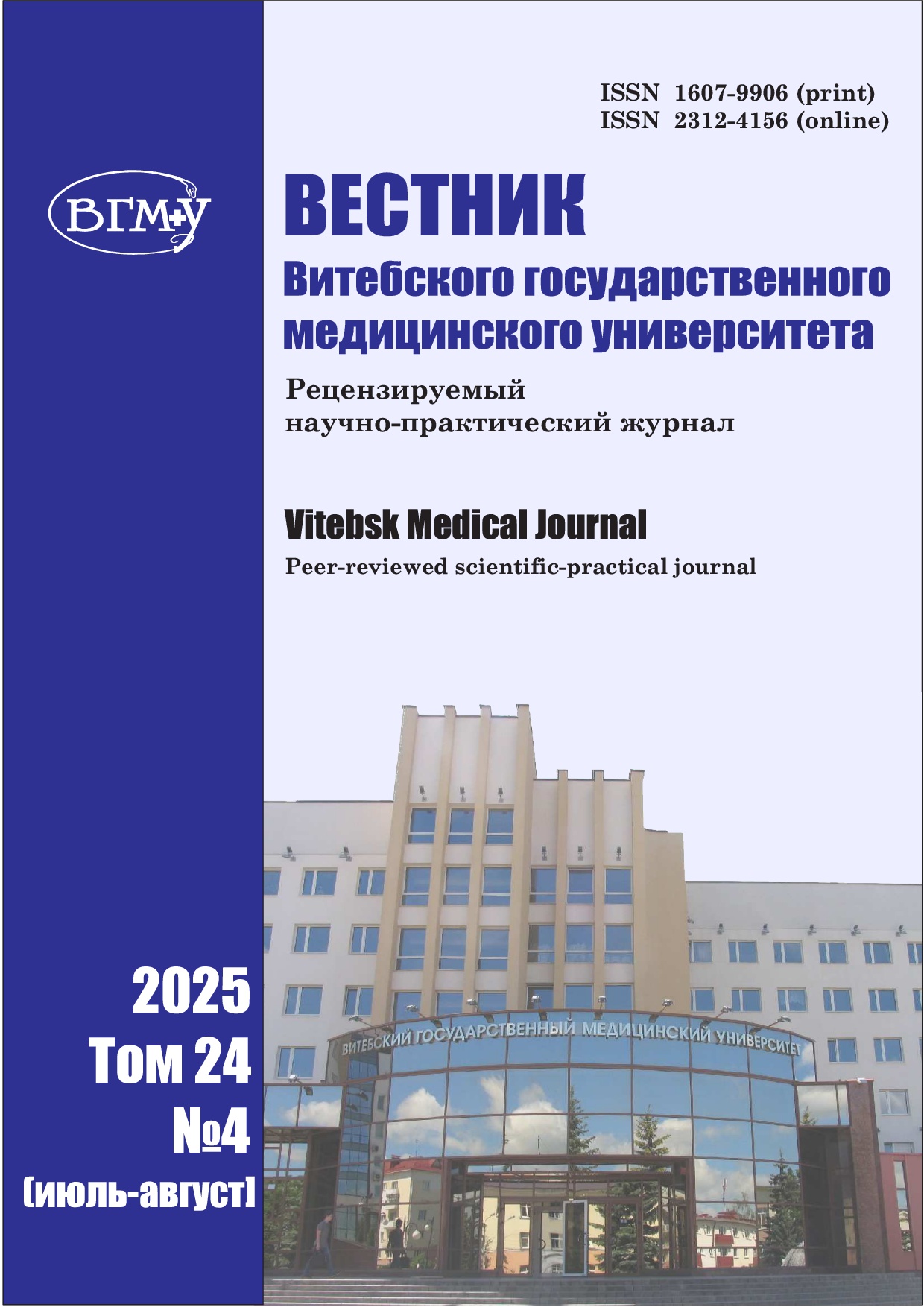Analysis of serum iron levels in patients with traumatic brain injury
Abstract
Abstract.
Decreased serum iron levels can be frequently observed in patients after traumatic brain injury.
Objectives. To investigate the dynamics of serum iron levels in patients with irreversible traumatic brain injury.
Material and methods. 107 patients with severe traumatic brain injury were included in the prospective non-randomized study. The patients were 52 (39; 60) years old; weight – 78 (70; 85) kg; 83 (77.6%) male and 24 (22.4%) female patients. Depending on the treatment outcome, 2 groups were formed: patients with a positive treatment outcome (group 1, n=56) and withan unfavorable results of intensive care (group 2, n=51), in whom the brain death was declared during treatment. In patients the serum iron levels were analyzed on the 1, 2, 3, 5, 7 and 10 days.
Results. Statistically significant differences were found between the two groups in: level of consciousness according to the Glasgow Coma Scale upon admission (12 (8; 14) points in group 1 and 5 (4; 6) points in group 2 (p<0.0001)); volume of the intracranial hematoma (76 (56; 107) ml and 150 (75; 185) ml, respectively (p=0.0057)); the volume of blood loss during surgery (293.5 (211; 505) ml and 500 (254; 750) ml, respectively (p=0.038)); severity of the condition according to the SOFA scale upon admission (3 (1; 6) points and 7.5 (6; 11) points, respectively, (p<0.0001)). No statistically significant differences in the serum iron level on the 1st and 2nd days were found: on the 1st day – 7.9 (4.1; 12.7) μmol/l in group 1 and 5.4 (2; 11.9) μmol/l in group 2 (p=0.48). On the 3rd and subsequent days of the study, statistically significant differences in the iron level between the groups of patients were observed: on the 3rd day - 5.1 (3.3; 9.8) μmol/l in group 1 and 3 (2; 4.1) μmol/l in group 2 (p=0.002).
Conclusions. Patients with the brain death have lower serum iron levels on the 3rd and subsequent days; it is associated with both greater brain damage and systemic inflammatory response syndrome, which increases significantly with brain death.
References
Щастный, А. Т. Достижения и проблемы трансплантологии на современном этапе / А. Т. Щастный, Е. В. Михневич // Вестник Витебского государственного медицинского университета. 2018. Т. 17, № 5. С. 7–16. DOI:10.22263/2312-4156.2018.5.7
Gunst, J. Management of the brain-dead donor in the intensive care unit / J. Gunst, M. J. Souter // Intensive care medicine. 2024 Apr. Vol. 50. P. 964–967. DOI:10.1007/s00134-024-07409-4
Медицинское сопровождение умершего донора со смертью головного мозга / В. В. Хмара, С. В. Головинский, А. Е. Щерба [и др.] // Здравоохранение (Минск). 2021. Т. 888, № 3. С. 35–43.
Липницкий, А. Л. Динамика показателей системного воспалительного ответа у пациентов со смертью мозга / А. Л. Липницкий, А. В. Марочков // Проблемы здоровья и экологии. 2024. Т. 21, № 4. С. 53–59. DOI:10.51523/2708-6011.2024-21-4-06
Маркевич, Д. П. Динамика содержания показателей водно-электролитного обмена у пациентов с черепно-мозговой травмой в периоперационном периоде / Д. П. Маркевич, А. В. Марочков, В. А. Ливинская // Журнал Гродненского государственного медицинского университета. 2020. Т. 18, № 5. С. 575–583. DOI:10.25298/2221-8785-2020-18-5-575-583
Bench-to-bedside review: iron metabolism in critically ill patients / M. Darveau, A. Y. Denault, N. Blais, E. Notebaert // Critical care. 2004 Oct. Vol. 8, № 5. P. 356–362. DOI:10.1186/cc2862
The influence of heavy metals and trace elements on comatose patients with severe traumatic brain injury in the first week of admission / B. Belatar, A. Elabidi, M. Barkiyou [et al.] // Journal of toxicology. 2018 Sep. Vol. 2018. Art. 7252606. DOI:10.1155/2018/7252606
Особенности обмена железа у пациентов с повреждением головного мозга и длительным нахождением в реанимационном отделении / Т. А. Степанюк, А. Л. Парфёнов, В. В. Милькин [и др.] // Здоровье и образование в ХХI веке. 2018. Т. 20, № 5. С. 36–40. DOI:10.26787/nydha-2226-7425-2018-20-5-36-40
Iron as an emerging therapeutic target in critically ill patients / C. Grange, F. Lux, T. Brichart [et al.] // Critical care. 2023 Dec. Vol. 27, № 1. P. 475. DOI:10.1186/s13054-023-04759-1
Ferritin, serum iron and hemoglobin as acute phase reactants in laparoscopic and open surgery of cholecystectomy: an observational prospective study / C. Vila Zárate, C. M. González, R. J. González Álvarez [et al.] // Pathophysiology. 2022. Vol. 29, № 4. P. 583–594. DOI:10.3390/pathophysiology29040045
Schmidt, P. J. Regulation of Iron Metabolism by Hepcidin under Conditions of Inflammation / P. J. Schmidt // The Journal of biological chemistry. 2015 Jul. Vol. 290, № 31. P. 18975–18983. DOI:10.1074/jbc.R115.650150
Оценка травматичности хирургических операций по динамике уровня сывороточного железа и с-реактивного белка / А. Л. Липницкий, А. В. Марочков, И. Я. Савостенко [и др.] // Новости хирургии. 2024. T. 31, № 6. C. 431–438. DOI: 10.18484/2305-0047.2023.6.431
A combination of serum iron, ferritin and transferrin predicts outcome in patients with intracerebral hemorrhage / G. Yang, R. Hu, C. Zhang [et al.] // Scientific reports. 2016 Feb. Vol.6. P. 21970. DOI:10.1038/srep21970
The role of iron in brain ageing and neurodegenerative disorders / R. J. Ward, F. A. Zucca, J. H. Duyn [et al.] // Lancet Neurol. 2014 Oct. Vol. 13, № 10. P. 1045–1060. DOI:10.1016/S1474-4422(14)70117-6


